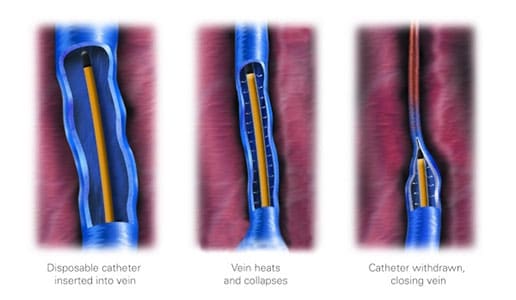RadioFrequency Ablation: How it works
Perhaps the most important thing to know about Radiofrequency Vein Ablation, is that it has a high success rate in treatment of varicose veins. Additionally, it is minimally invasive, minimally painful, has low rates of complication, can be performed in-office, and has a very rapid recovery time, usually about a day.
The Venous Ablation Process
 Introduced in 1999, radiofrequency vein ablation has helped to further revolutionize the management of superficial venous reflux disease, or Chronic Venous Insufficiency, and varicose veins. Using ultrasound to guide them, a vein specialists charged catheter delivers 350-500KHz of radio energy along the path of damaged veins. The affected veins close and are resorbed by the body, and blood flow is rerouted through healthy veins. Prior to operating the RF device, the adjacent tissues are surrounded by a tumescent solution, protecting the area and preventing the patient from feeling discomfort from the heat energy.
Introduced in 1999, radiofrequency vein ablation has helped to further revolutionize the management of superficial venous reflux disease, or Chronic Venous Insufficiency, and varicose veins. Using ultrasound to guide them, a vein specialists charged catheter delivers 350-500KHz of radio energy along the path of damaged veins. The affected veins close and are resorbed by the body, and blood flow is rerouted through healthy veins. Prior to operating the RF device, the adjacent tissues are surrounded by a tumescent solution, protecting the area and preventing the patient from feeling discomfort from the heat energy.
The procedure is very effective in the treatment of large vein varicosities including; the great saphenous vein, small saphenous vein, and perforator veins which link the superficial venous system to the deeper veins.
Learn More about RadioFrequency Vein Ablation
When performed by an experienced, qualified Vein Specialist, success rates for radiofrequency ablation exceed 97%. To see whether you can benefit from this advanced varicose vein treatment, book a consultation and exam with a qualified vein specialist.
References:
https://www.ncbi.nlm.nih.gov/pmc/articles/PMC3377553/: retrieved October 15, 2016
Question: What can a venous reflux exam tell me? How does this treatment measure my veins effectiveness?
Read MoreQuestion: How long does the actual varicose vein surgery itself take and how much time should I expect for the recovery?
Read MorePregunta: ¿Cuáles son las mejores maneras de juzgar las calificaciones de un médico para el tratamiento de las venas? Mis venas están en forma horrible, y me dijeron recientemente que necesitaría 5 procedimientos diferentes de ablación y 6 citas de escleroterapia después. Tuve mi primer procedimiento VNUS por un médico de la vena en Gilbert…
Read MorePregunta: tuve mis inyecciones (escleroterapia) hace 3 semanas (no en el Instituto de vena avanzada de Arizona). Mi tobillo todavía está terriblemente hinchado. He vuelto dos veces para una ecografía y ningún coágulo. ¿Cuánto dura la hinchazón normalmente? Yo camino y no usar mis medias como se indica. Me está disuadiendo de continuar el tratamiento,…
Read MoreQuestion: What are the best ways to judge a doctor’s qualifications for vein treatment? My veins are in horrible shape, and I was recently told that I would need 5 different ablation procedures and 6 Sclerotherapy appointments afterwards. I had my first VNUS procedure by a vein doctor in Gilbert on the greater saphenous vein, and…
Read MoreQuestion: I had my injections (Sclerotherapy) done 3 weeks ago (not at Advanced Vein Institute of Arizona). My ankle is still terribly swollen. I’ve been back twice for an ultrasound and no clot. How long does the swelling normally last? I walk and did wear my stockings as directed. It is deterring me from continuing treatment…
Read MorePregunta: ¿se pueden tratar las venas normales? Así que tengo venas de color verde azulado muy largas en mi muñeca. Sé que hay normalidad pero odio cómo se ven. ¿Puedo tratarlo con escleroterapia? También tengo 2 largas venas verdes en mi pecho. ¡Ayuda! También tengo 15 años, ¿puedo pasar por la escleroterapia?
Read MoreQuestion: Can normal veins be treated? So I have normal very long green bluish color veins in my wrist. I know there normal but I hate how they look. Can I treat it with sclerotherapy? I also have 2 long green veins in my chest. Help! Also I’m 15, can I go through sclerotherapy?
Read MorePregunta: Tengo 50 años de edad; un soltero, y un maestro. En este momento tengo varices (aunque no son dolorosas) en mi pierna derecha. No estoy feliz de verlos. ¿Qué puede sugerir para disminuir su visibilidad?
Read MoreQuestion: What is “extensive vascular calcium deposits” when shown on X-rays?
Read More